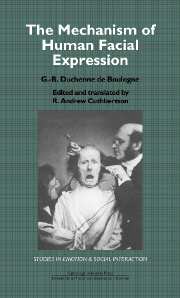Book contents
- Frontmatter
- Contents
- Acknowledgments
- Contributors
- Editor's Preface
- Part 1 The mechanism of human facial expression or an electrophysiological analysis of the expression of the emotions
- Part 2 Commentary chapters
- Chapter 1 The highly original Dr. Duchenne
- Chapter 2 The Duchenne de Boulogne Collection in The Department of Morphology, L'École Nationale Supérieure des Beaux Arts
- Chapter 3 Duchenne today: Facial expression and facial surgery
- Chapter 4 Duchenne and facial expression of emotion
- Index
Chapter 3 - Duchenne today: Facial expression and facial surgery
Published online by Cambridge University Press: 10 November 2010
- Frontmatter
- Contents
- Acknowledgments
- Contributors
- Editor's Preface
- Part 1 The mechanism of human facial expression or an electrophysiological analysis of the expression of the emotions
- Part 2 Commentary chapters
- Chapter 1 The highly original Dr. Duchenne
- Chapter 2 The Duchenne de Boulogne Collection in The Department of Morphology, L'École Nationale Supérieure des Beaux Arts
- Chapter 3 Duchenne today: Facial expression and facial surgery
- Chapter 4 Duchenne and facial expression of emotion
- Index
Summary
Their debt to Duchenne is rarely realized by surgeons who operate to restore facial expression. Whether dealing with muscle dysfunction or the aging process, our work rests on the foundation of Duchenne's studies. That this area of supreme psychological significance should owe so much to one of the founders of neurology, the mentor of Charcot and, therefore, ultimately of Freud, should give us all much food for thought. The triad of Duchenne's advances has survived largely unchallenged: the application of electrical stimulation to facial nerves and muscles, his introduction of clinical photography, and his profound analysis of the form and function of the facial musculature.
Electrical stimulation of muscles and nerves is still widely practiced, even during operations. Although his photographs are only snapshots from the process of facial movement, the evolution to recording the animation of the face on film and video was inevitable. Interpreting facial function in terms of muscle action rather than mere morphology, Duchenne revolutionized the understanding of expressive facial movement, and helped prepare a firm foundation for modern techniques of facial reanimation. Duchenne's “mask of muscles” has been recently restudied, confirming the relationship between individual facial muscles and total facial function.
Surgical advances in the management of both asymmetry and aging of the face are indirectly indebted to Duchenne. His description of secondary creaselines masking primary expression lines explains the rejuvenating effect of facelifting operations and their psychological value by restoring an illusion of youth.
- Type
- Chapter
- Information
- The Mechanism of Human Facial Expression , pp. 257 - 269Publisher: Cambridge University PressPrint publication year: 1990
- 1
- Cited by



